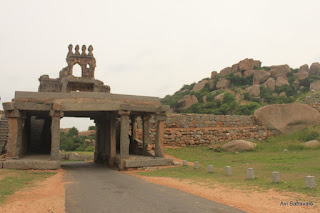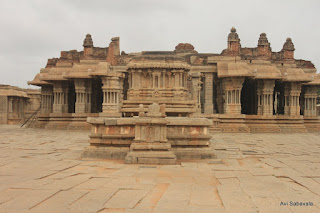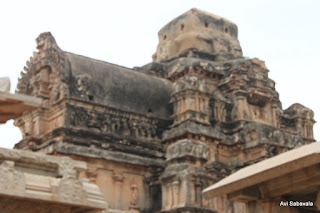On a hot afternoon on day 1, after being filled with the sublime beauty of the temple artistry at Pattadakal and Aihole, we begin exploring the ruins of what was once the glorious city that was Hampi. All are not ruins however, and there are some fairly well maintained structures especially the temples. In addition you get to see the royal enclosures as well as dwellings for the guards and elephants. Excavations are on by the ASI, and time may reveal many more secrets about this very interesting period in Indian history
Entering from the Eastern side, you come across this huge daunting statue of Lakshmi-Narsimha statue
 |
| ShivLing |
 |
| Hemkunta Hill |
 |
| Krishna Temple exterior |
 |
| Ganesha statue |
 |
| View of Hampi from the Hemkunta hill |
 |
| Ruins at Hemkunta Hill |
 |
| Entry to the Virupaksha temple believed to be even older than the temple was renovated by Krishnadevarayya II |
 |
| Virupaksha Temple photo taken from the Hemkunta hill- this temple still has religious offerings being made |
 |
| Wari devotees throng the temple after walking for 10 days from their village |
Day 2 entrance is from the Southern side, - this is the Bhima gate
 |
| the remains of market place |
 |
| Entry to the famous Vithala Temple |
the famous Chariot which is the icon of Hampi.
 |
| View of the Queen's bath - this square structure u surrounded by arched corridors and protruding filigreed balconies |
 |
| a secret underground passage |
Views of the Hazara Rama temple depicts scenes from the Ramayana. hazara mean thousand
 |
| exterior of the Hazara Rama Temple |
On the way to the Lotus temple is an interesting turret probably used as a watchtower
 |
| View of the Lotus Mahal - a residence for Royal Ladies |
 |
| Exterior of the Lotus Mahal |
 |
| Elephant Stables |
 |
| In the distance a bear comes to eat the food put out by the Forest department |
 |
| Forest Calotes at Daroji |










































No comments:
Post a Comment